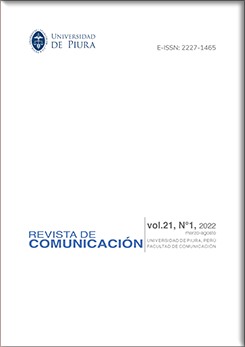The pact of veridiction in the series Chernobyl. The truth and the historical lie from the film
DOI:
https://doi.org/10.26441/RC21.1-2022-A2Keywords:
Chernobyl, disaster, reality, reconstruction, history, censorship, narratives, ideology, journalism, veridictionAbstract
On 26 April 1986, one of the most important events in the history of nuclear energy took place: the Chernobyl accident. This historic event marked the decline of the Soviet Union, an environmental agenda and new geopolitics of the world. It has been portrayed in literature, film, photo-reportage and documentary, among others. This paper seeks to analyse and contrast the HBO series Chernobyl (2019) and Svetalna Alexievich's Voices from Chernobyl (1997), specifically the relationship between reality and literary and filmic reconstruction. For this purpose, we use a descriptive-argumentative logic and a visual analysis with a mixed methodology. The analysis reveals a conflictive relationship between the two works, since the testimonies recorded in the book are easily recognisable in the series, although the latter has never specified that they are based on the book. Among the conclusions, the narrative structure carrying ideology (which seeks to strengthen a collective imaginary over the commonly accepted biases about the Soviet Union and its model of socialism), carried out with remarkable art direction, stands out. Finally, the series comes at a time of widespread debate in civil society about the use of nuclear energy, just as the end of the current model of fossil fuel-based energy generation for society and heavy industry approaches.
Metrics
References
Agüero García, J. (2017). La plegaria de Chernóbil: memoria del desastre nuclear en el contexto de un poder agonizante. Revista Estudios, Núm. 35. DOI: https://doi.org/10.15517/re.v0i35.31593
Aleksiévich, S. (1997). Voces de Chernóbil. Debate.
Arrojo, M. J. y Martín, E. (2019). El seguimiento activo de las series de ficción en internet. La atención y la emoción como desencadenantes del binge-watching. Revista de Comunicación. Vol. 18(2). https://doi.org/10.26441/RC18.2-2019-A1-1 DOI: https://doi.org/10.26441/RC18.2-2019-A1-1
Barthes, R. (1992). Lo obvio y lo obtuso: imágenes, gestos, voces. Paidós.
Berger, J. (1997). Otra manera de contar. Mestizo.
Blanco Pérez, M. (2020). Cine y Semiótica: La Teoría del Emplazamiento / Desplazamiento aplicada al lenguaje cinematográfico y Publicitario. Universidad de Salamanca.
Blanco Pérez, M. (2021). Cine y semiótica Transdiscursiva. El cine digital en la era de las multipantallas: un nuevo entorno, un nuevo espectador. Comunicación y Sociedad, e7886. https://doi.org/10.32870/cys.v2021.7886 DOI: https://doi.org/10.32870/cys.v2021.7886
Blanco Pérez, M. (2022). Cine, fotografía y arquitectura: la composición simétrica y la noción de arquitecturización en la obra de Wes Anderson. Antecedentes visuales de la película La crónica francesa (2021). Arte, Individuo y Sociedad. Vol. 34 Núm. 4. DOI: https://doi.org/10.5209/aris.78848
Blanco Pérez, M. y Balleta, E. (2022). La guerra civil española en el cine como fuente historiográfica: la Andalucía del filme La Trinchera Infinita (2019) y la reconstrucción digital de un fascismo invisible. Tempo e Argumento, 13 (34), pp. 1-22. http://dx.doi.org/10.5965/2175180313342021e0204 DOI: https://doi.org/10.5965/2175180313342021e0204
Cantó, A. (2011). La pizarra de Yuri. Historia de ciencia al calor del fuego. Silente libros.
Casetti, F. y Di Chio, F. (1991). Cómo analizar un film. Paidós.
Coathes, S. (2015). X-Ray Audio. Strange Attractor Press
Coelho, I. y Sossai, F. C. (2016). Aproximações entre história pública e história oral: o caso do Laboratório de História Oral da Univille. Revista Tempo e Argumento. V. 8, n. 19. http://dx.doi.org/10.5965/2175180308192016096 DOI: https://doi.org/10.5965/2175180308192016096
Cotarelo Comerón, D. (2016). K. en Baltimore. Afinidades narrativas entre The Wire y El castillo. Revista de Comunicación. Vol. 16 (1). DOI: https://doi.org/10.26441/RC16.1-2017-A3
Davies, T. y Polese, A. (2015). Informalidad y supervivencia en Chernóbil: etnografía de un espacio nuclear. Methaodos Revista de ciencias sociales. Núm. 3 (2). http://dx.doi.org/10.17502/m.rcs.v3i2.87 DOI: https://doi.org/10.17502/m.rcs.v3i2.87
Donstrup, M. (2018). Vikings: poder e identidades culturales en la serie de History Channel. Revista de Comunicación. Vol. 17 (1). https://doi.org/10.26441/RC17.1-2018-A3 DOI: https://doi.org/10.26441/RC17.1-2018-A3
Gale, R. P. y Hauser, T. (1990). El último aviso: el legado de Chernobyl. Ediciones Clip.
Gorbachov, M. (1993). Memorias de los años decisivos (1985-1992). Acento Editorial.
Gubaryev, V. (1987). Sarcophagus: a tragedy. RSC.
Hutchings, R. (1971). El Desarrollo Económico Soviético 1917-1970. Historia y planificación. Ediciones Istmo.
Jauss, H. R. (2000). La Literatura como una provocación. Península.
Kostin, I. (2011). Chernóbil: confesiones de un reportero. Efadós.
Leatherbarrow, A. (2019). Chernóbil. 01:23:40: La verdadera historia del desastre nuclear que conmocionó al mundo. Duomo Ediciones.
Lubarsky, C. (1991). La tragedia de Chernóbyl. Círculo de Lectores.
Mahon, N. (2010). Dirección de arte en Publicidad. Gustavo Gili.
Marzal, J. (2007). Cómo se lee la fotografía. Cátedra.
McMillan, D. (2015). Growth and Decay. Steidl.
Medvédev, G. (1992). La verdad sobre Chernóbil. Testimonio.
Palazuelos, E. (1990). La formación del sistema económico de la Unión Soviética. Akal.
Pallarès-Piquer, M., Hernández, J. D., Castañeda, W. J. y Osorio, F. (2020). Vivir tras la catástrofe. El arte como intersección entre la imagen viviente y la conciencia. Una aproximación a la serie Chernobyl desde la ontología de la imagen. Arte, Individuo y Sociedad. Núm. 32 (3). https://dx.doi.org/10.5209/aris.65826 DOI: https://doi.org/10.5209/aris.65826
Plokhy, S. (2015). El último imperio. Los días finales de la Unión Soviética. Turner.
Roca, D. (1998). El director de arte publicitario. 80 años después de su nacimiento. Revista Latina de Comunicación Social, Núm. 12. https://ddd.uab.cat/pub/artpub/1998/167479/revlatcom_a1998m12n12p8.pdf
Rodríguez Fidalgo, M. I., Paíno Ambrosio, A. y Ruiz Paz, Y. (2021). La plataforma Dark. Netflix como ejemplo de estrategia de amplificación de la transficcionalidad transmedia. https://doi.org/10.26441/RC20.2-2021-A18 DOI: https://doi.org/10.26441/RC20.2-2021-A18
Sánchez, C. (2007). El accidente de Chernóbil. Revista de Comunicación Vivat Academia. Año X, Núm. 82. http://dx.doi.org/10.15178/va.2007.82.1-32 DOI: https://doi.org/10.15178/va.2007.82.1-32
Schlögel, K. (2021). El siglo soviético. Arqueología de un mundo perdido. Galaxia Gutemberg.
Smith, J. T. y Beresford, N. A. (Eds.) (2005). Chernobyl: Catastrophe and Consequences. Springer.
Taibo, C. (2000). La explosión soviética. Espasa.
Zunzunegui, S. (2007). Acerca del análisis fílmico: el estado de las cosas. Comunicar. Núm. 29. https://doi.org/10.3916/C29-2007-07 DOI: https://doi.org/10.3916/C29-2007-07
Zunzunegui, S. (1995). Pensar la imagen. Cátedra.
Downloads
Published
How to Cite
Issue
Section
License
Copyright (c) 2022 Revista de Comunicación

This work is licensed under a Creative Commons Attribution-NonCommercial-NoDerivatives 4.0 International License.












 Portal de Revistas de la Universidad de Piura.
Portal de Revistas de la Universidad de Piura.